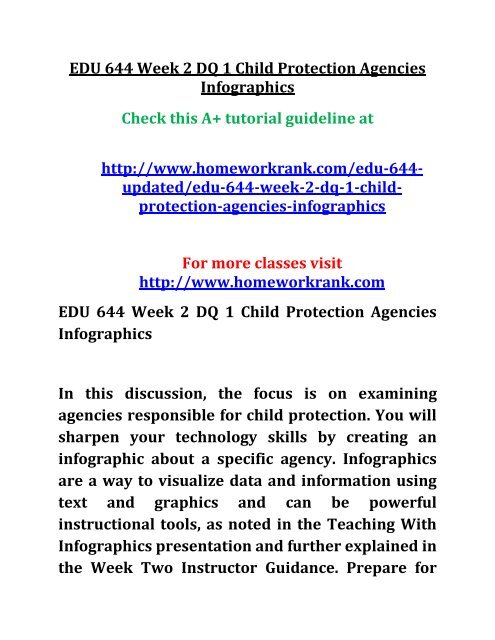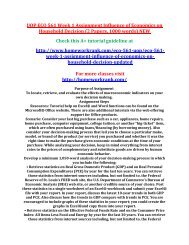EDU 644 Week 2 DQ 1 Child Protection Agencies Infographics
You also want an ePaper? Increase the reach of your titles
YUMPU automatically turns print PDFs into web optimized ePapers that Google loves.
<strong>EDU</strong> <strong>644</strong> <strong>Week</strong> 2 <strong>DQ</strong> 1 <strong>Child</strong> <strong>Protection</strong> <strong>Agencies</strong><br />
<strong>Infographics</strong><br />
Check this A+ tutorial guideline at<br />
http://www.homeworkrank.com/edu-<strong>644</strong>-<br />
updated/edu-<strong>644</strong>-week-2-dq-1-childprotection-agencies-infographics<br />
For more classes visit<br />
http://www.homeworkrank.com<br />
<strong>EDU</strong> <strong>644</strong> <strong>Week</strong> 2 <strong>DQ</strong> 1 <strong>Child</strong> <strong>Protection</strong> <strong>Agencies</strong><br />
<strong>Infographics</strong><br />
In this discussion, the focus is on examining<br />
agencies responsible for child protection. You will<br />
sharpen your technology skills by creating an<br />
infographic about a specific agency. <strong>Infographics</strong><br />
are a way to visualize data and information using<br />
text and graphics and can be powerful<br />
instructional tools, as noted in the Teaching With<br />
<strong>Infographics</strong> presentation and further explained in<br />
the <strong>Week</strong> Two Instructor Guidance. Prepare for
this discussion by reading Rubin (2012) Chapter 1,<br />
the Principles and Philosophy resource, and the<br />
<strong>Week</strong> Two Instructor Guidance. Then, using the<br />
software of your choosing, be sure to attach or link<br />
to your infographic in your initial post. Your<br />
infographic will be included in the <strong>Week</strong> Six Final<br />
Project.<br />
Initial Post: Create an infographic using the<br />
software of your choice that includes the<br />
following:<br />
a. An engaging title for the infographic.<br />
b. A summary of a specific child protection<br />
agency’s vision, mission, guiding principles, or<br />
philosophies.<br />
c. A summary of how the agency’s philosophies,<br />
principles, and key policies support or align with
the philosophical tenets promoted by the Adoption<br />
and Safe Families Act (ASFA) 1997.<br />
d. At least one image in the infographic.<br />
e. A references section that cites all information<br />
summarized in the infographic, including the child<br />
protection agency you researched and at least one<br />
other local, state, national, for-profit or non-profit<br />
organization.<br />
Guided Response: Respond to a minimum of two<br />
peers. In your responses, discuss the design of the<br />
infographic (e.g., colors, layout, graphics) and the<br />
quality of the information shared. Make<br />
recommendations to peers about how they might<br />
enhance their infographic, drawing on the<br />
principles discussed in the Teaching With<br />
<strong>Infographics</strong> presentation for design of<br />
infographics, and about the content summarized.<br />
Though two replies is the minimum expectation
for this discussion, for deeper engagement and<br />
learning you are encouraged to provide responses<br />
to any comments or questions others have<br />
provided to you to further the conversation.<br />
Remember, this continued engagement also<br />
provides you with opportunities to demonstrate<br />
your content expertise, critical thinking, and any<br />
real world experiences you may have with the<br />
topic of child protection agencies.
















